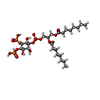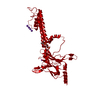[English] 日本語
 Yorodumi
Yorodumi- PDB-6xev: CryoEM structure of GIRK2-PIP2/CHS - G protein-gated inwardly rec... -
+ Open data
Open data
- Basic information
Basic information
| Entry | Database: PDB / ID: 6xev | ||||||
|---|---|---|---|---|---|---|---|
| Title | CryoEM structure of GIRK2-PIP2/CHS - G protein-gated inwardly rectifying potassium channel GIRK2 with modulators cholesteryl hemisuccinate and PIP2 | ||||||
 Components Components | G protein-activated inward rectifier potassium channel 2 | ||||||
 Keywords Keywords | TRANSPORT PROTEIN / CryoEM / GIRK / inwardly rectifying potassium channel / cholesterol / lipids / PIP2 | ||||||
| Function / homology |  Function and homology information Function and homology informationG-protein activated inward rectifier potassium channel activity / inward rectifier potassium channel complex Similarity search - Function | ||||||
| Biological species |  | ||||||
| Method | ELECTRON MICROSCOPY / single particle reconstruction / cryo EM / Resolution: 3.5 Å | ||||||
 Authors Authors | Mathiharan, Y.K. / Glaaser, I.W. / Skiniotis, G. / Slesinger, P.A. | ||||||
| Funding support |  United States, 1items United States, 1items
| ||||||
 Citation Citation |  Journal: Cell Rep / Year: 2021 Journal: Cell Rep / Year: 2021Title: Structural insights into GIRK2 channel modulation by cholesterol and PIP. Authors: Yamuna Kalyani Mathiharan / Ian W Glaaser / Yulin Zhao / Michael J Robertson / Georgios Skiniotis / Paul A Slesinger /  Abstract: G-protein-gated inwardly rectifying potassium (GIRK) channels are important for determining neuronal excitability. In addition to G proteins, GIRK channels are potentiated by membrane cholesterol, ...G-protein-gated inwardly rectifying potassium (GIRK) channels are important for determining neuronal excitability. In addition to G proteins, GIRK channels are potentiated by membrane cholesterol, which is elevated in the brains of people with neurodegenerative diseases such as Alzheimer's dementia and Parkinson's disease. The structural mechanism of cholesterol modulation of GIRK channels is not well understood. In this study, we present cryo- electron microscopy (cryoEM) structures of GIRK2 in the presence and absence of the cholesterol analog cholesteryl hemisuccinate (CHS) and phosphatidylinositol 4,5-bisphosphate (PIP). The structures reveal that CHS binds near PIP in lipid-facing hydrophobic pockets of the transmembrane domain. Our structural analysis suggests that CHS stabilizes PIP interaction with the channel and promotes engagement of the cytoplasmic domain onto the transmembrane region. Mutagenesis of one of the CHS binding pockets eliminates cholesterol-dependent potentiation of GIRK2. Elucidating the structural mechanisms underlying cholesterol modulation of GIRK2 channels could facilitate the development of therapeutics for treating neurological diseases. VIDEO ABSTRACT. | ||||||
| History |
|
- Structure visualization
Structure visualization
| Movie |
 Movie viewer Movie viewer |
|---|---|
| Structure viewer | Molecule:  Molmil Molmil Jmol/JSmol Jmol/JSmol |
- Downloads & links
Downloads & links
- Download
Download
| PDBx/mmCIF format |  6xev.cif.gz 6xev.cif.gz | 242.8 KB | Display |  PDBx/mmCIF format PDBx/mmCIF format |
|---|---|---|---|---|
| PDB format |  pdb6xev.ent.gz pdb6xev.ent.gz | 190.5 KB | Display |  PDB format PDB format |
| PDBx/mmJSON format |  6xev.json.gz 6xev.json.gz | Tree view |  PDBx/mmJSON format PDBx/mmJSON format | |
| Others |  Other downloads Other downloads |
-Validation report
| Summary document |  6xev_validation.pdf.gz 6xev_validation.pdf.gz | 1.3 MB | Display |  wwPDB validaton report wwPDB validaton report |
|---|---|---|---|---|
| Full document |  6xev_full_validation.pdf.gz 6xev_full_validation.pdf.gz | 1.4 MB | Display | |
| Data in XML |  6xev_validation.xml.gz 6xev_validation.xml.gz | 50.9 KB | Display | |
| Data in CIF |  6xev_validation.cif.gz 6xev_validation.cif.gz | 62.5 KB | Display | |
| Arichive directory |  https://data.pdbj.org/pub/pdb/validation_reports/xe/6xev https://data.pdbj.org/pub/pdb/validation_reports/xe/6xev ftp://data.pdbj.org/pub/pdb/validation_reports/xe/6xev ftp://data.pdbj.org/pub/pdb/validation_reports/xe/6xev | HTTPS FTP |
-Related structure data
| Related structure data |  22154MC  6xeuC M: map data used to model this data C: citing same article ( |
|---|---|
| Similar structure data |
- Links
Links
- Assembly
Assembly
| Deposited unit | 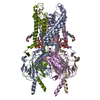
|
|---|---|
| 1 |
|
- Components
Components
| #1: Protein | Mass: 39061.957 Da / Num. of mol.: 4 / Fragment: UNP residues 34-362 Source method: isolated from a genetically manipulated source Source: (gene. exp.)   Komagataella pastoris (fungus) / References: UniProt: A0A338P6L0 Komagataella pastoris (fungus) / References: UniProt: A0A338P6L0#2: Chemical | ChemComp-PIO / [( #3: Chemical | ChemComp-Y01 / #4: Chemical | ChemComp-K / #5: Chemical | ChemComp-NA / Has ligand of interest | Y | Has protein modification | Y | |
|---|
-Experimental details
-Experiment
| Experiment | Method: ELECTRON MICROSCOPY |
|---|---|
| EM experiment | Aggregation state: PARTICLE / 3D reconstruction method: single particle reconstruction |
- Sample preparation
Sample preparation
| Component | Name: G protein-gated inwardly rectifying potassium channel (GIRK2) Type: COMPLEX Details: CryoEM structure of G protein-gated inwardly rectifying potassium channel GIRK2 with modulators cholesteryl hemisuccinate and PIP2 Entity ID: #1 / Source: RECOMBINANT | ||||||||||||||||||||||||||||||||||||||||
|---|---|---|---|---|---|---|---|---|---|---|---|---|---|---|---|---|---|---|---|---|---|---|---|---|---|---|---|---|---|---|---|---|---|---|---|---|---|---|---|---|---|
| Source (natural) | Organism:  | ||||||||||||||||||||||||||||||||||||||||
| Source (recombinant) | Organism:  Komagataella pastoris (fungus) Komagataella pastoris (fungus) | ||||||||||||||||||||||||||||||||||||||||
| Buffer solution | pH: 7.5 | ||||||||||||||||||||||||||||||||||||||||
| Buffer component |
| ||||||||||||||||||||||||||||||||||||||||
| Specimen | Embedding applied: NO / Shadowing applied: NO / Staining applied: NO / Vitrification applied: YES Details: CryoEM structure G protein-gated inwardly rectifying potassium channel GIRK2 with modulators cholesteryl hemisuccinate and PIP2 | ||||||||||||||||||||||||||||||||||||||||
| Specimen support | Grid material: GOLD / Grid mesh size: 200 divisions/in. / Grid type: Quantifoil R1.2/1.3 | ||||||||||||||||||||||||||||||||||||||||
| Vitrification | Instrument: FEI VITROBOT MARK IV / Cryogen name: ETHANE / Humidity: 100 % / Chamber temperature: 293 K |
- Electron microscopy imaging
Electron microscopy imaging
| Experimental equipment |  Model: Titan Krios / Image courtesy: FEI Company |
|---|---|
| Microscopy | Model: TFS KRIOS |
| Electron gun | Electron source:  FIELD EMISSION GUN / Accelerating voltage: 300 kV / Illumination mode: FLOOD BEAM FIELD EMISSION GUN / Accelerating voltage: 300 kV / Illumination mode: FLOOD BEAM |
| Electron lens | Mode: BRIGHT FIELD / Nominal defocus max: 2200 nm / Nominal defocus min: 1500 nm / Cs: 2.7 mm |
| Specimen holder | Cryogen: NITROGEN / Specimen holder model: FEI TITAN KRIOS AUTOGRID HOLDER |
| Image recording | Average exposure time: 3 sec. / Electron dose: 83 e/Å2 / Film or detector model: GATAN K3 (6k x 4k) |
- Processing
Processing
| EM software |
| |||||||||||||||||||||
|---|---|---|---|---|---|---|---|---|---|---|---|---|---|---|---|---|---|---|---|---|---|---|
| CTF correction | Type: PHASE FLIPPING AND AMPLITUDE CORRECTION | |||||||||||||||||||||
| Particle selection | Num. of particles selected: 297174 | |||||||||||||||||||||
| Symmetry | Point symmetry: C4 (4 fold cyclic) | |||||||||||||||||||||
| 3D reconstruction | Resolution: 3.5 Å / Resolution method: FSC 0.143 CUT-OFF / Num. of particles: 44990 / Num. of class averages: 2 / Symmetry type: POINT | |||||||||||||||||||||
| Atomic model building | Protocol: FLEXIBLE FIT | |||||||||||||||||||||
| Atomic model building | PDB-ID: 3SYA Accession code: 3SYA / Source name: PDB / Type: experimental model |
 Movie
Movie Controller
Controller







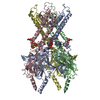
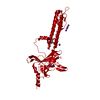
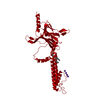
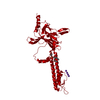
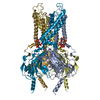



 PDBj
PDBj